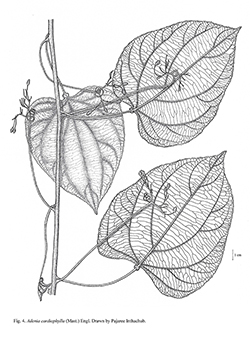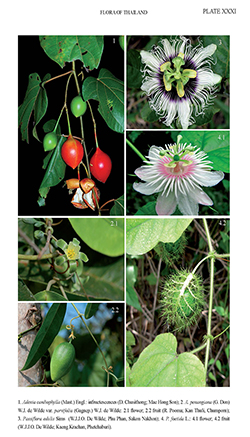e-Flora of Thailand
Volume 10 > Part 2 > Year 2010 > Page 244 > Passifloraceae > Adenia
3. Adenia cardiophylla (Mast.) Engl.wfo-0000519941
Bot. Jahrb. Syst. 14: 376. 1891; Craib, Fl. Siam. Enum. 1: 745. 1931; Chakrav., Bull. Bot. Soc. Bengal 3, 1: 66, p.p., excluding specimens from Andaman, Nicobar & Coco Isl. 1951; W.J.de Wilde, Meded. Landbouwhogeschool Wageningen 71, 18: 209, f. 34. 1971.— Modecca cardiophylla Mast., in Hook.f., Fl. Brit. Ind. 2: 602. 1879. Fig. 4; Plate XXXI: 1.
Accepted Name : This is currently accepted.
Synonyms & Citations :
Description : Climber to 25 m long; subglabrous; branches greenish to brownish, 2–6 mm thick. Stipules triangular or rounded, 1.5–1 mm long. Leaves: petiole (2–)3–10 cm long; blade entire (rarely 3-lobed), ovate in outline, (5–)7–25 by (4)5–19 cm, base cordate to subtruncate, apex subobtuse to acute, up to 1 cm acuminate, 3–5-plinerved, venation distinctly scalariform, prominent on both surfaces, pale yellowish green; lobes to 7 cm long; petiole with 2 glands at the apex on two semicircular auricles, 2.5–4 mm diam. Inflorescences pedunculate for (0.5–)4–18 cm, up to 20 flowered in male, 1–3-flowered in female; tendrils (0–)1(–3). Sterile tendril up to 20 cm long. Bracts and bracteoles (narrowly) triangular, acute, ca 1 mm long. Male flowers: pedicel 5–10 mm long; flower tubiform-campanulate, including the 6–12 mm long stipe 16–25 by 4.5–8 mm, calyx lobes at anthesis somewhat recurved; hypanthium including calyx tube widening towards apex, 6.5–10 mm long; calyx lobes long-triangular, obtuse or acute, 4–5(–6) mm long; petals narrowly triangular or oblong, 5–7 by 2.5–3.5 mm, obtuse, 3–5-nerved, entire or finely serrate, inserted ca 2 mm below the throat of the calyx tube; filaments 3.5–5.5 mm, connate for 2.5–4 mm, inserted at the base of the hypanthium, anthers 4.5–5.5 by 0.8–1.5 mm, subacute, up to 0.5 mm apiculate; septa 1–1.5 mm high; corona absent; disc glands ca 2 mm long. Female flowers: pedicel 2–10 mm long; flower tubiform-campanulate, including the 1–3 mm long stipe 11–15 by 4.5–8 mm; gynophore 2–4 mm long; ovary ellipsoid, 4 4.5 by 2.5–4 mm; styles connate for 0.5–1 mm, style arms 0.5–1 mm long; stigmas subreniform, lobed-laciniate, each 2.5–3 mm diam. Fruit 1 or 2 per infructescence, obovate or pear-shaped, excluding the tapering 4–7.5 cm long gynophore 5–11(–12) by 2.5–7 cm, apex subacute to rounded; pericarp woody outside, somewhat spongy inside, 5–20 mm thick. Seeds numerous, suborbicular or broadly reniform, 6–8.5 by 8–10 by 2.5–3.5 mm, muricately pitted.
Thailand : NORTHERN: Chiang Mai (Doi Suthep, Doi Chawmhat, Doi Chan Pa Di, Ban Pa Deng, Doi Chiang Dao WS), Tak (Doi Musor); NORTH-EASTERN: Loei (Dan Sai), Nong Khai (Chaiyaburi); SOUTH-WESTERN: Kanchanaburi (Dongyai, Srisawat).
Distribution : India (Sikkim, Assam (type), Manipur), Myanmar, China (Yunnan), Laos.
Ecology : Grassy areas, thickets, and along small streams in primary evergreen mixed forests; shale and granite bedrock, and limestone outcrops; at 700–1,600 m alt. Flowering: May–June; fruiting: May and October.
Notes: Adenia cardiophylla is similar to A. heterophylla, the latter is distinct in the thin pericarp, smaller flowers, the distinct but not raised venation of the leaves, its different distributional area, and altitude of occurrence.
Fresh flowers are reported as pale greenish or pale yellow and once as reddish yellow; dry flowers are purple or reddish veined and striped; ripe fruits are red.


